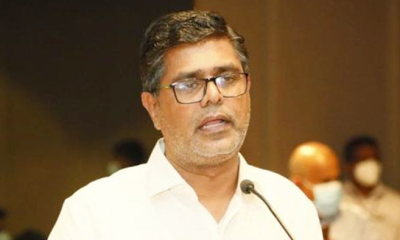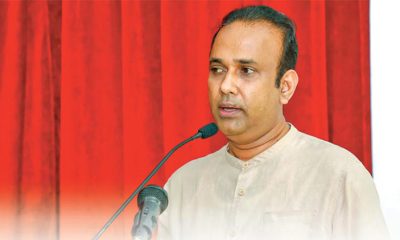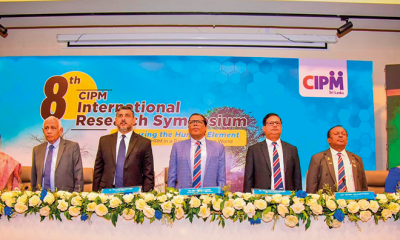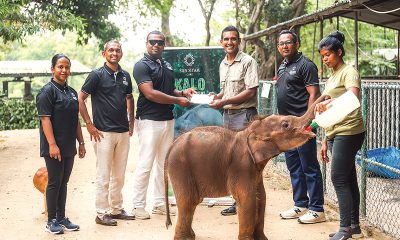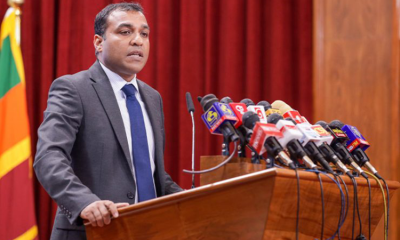Features
Veddahs, jungle creatures, medicinal plants and the cry of the ‘devil’ bird
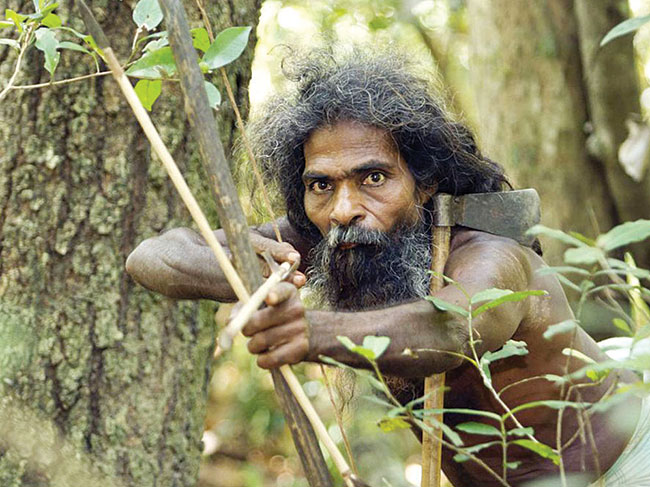
(Continued from last week)
By Jayantha Jayewardene
Jackal
I have heard it said that the jackal has a unique way of getting rid of the ticks and fleas that get onto its skin and hide in its thick hair. It gets a piece of coconut husk in its mouth and wades into a stream with the husk held high. It goes deeper and deeper into the water till the drowning fleas all move up and get onto the husk, which is still above the water. Then the jackal releases the coconut husk into the water, thus drowning the fleas and then comes back to shore. I have not seen a jackal with a coconut husk or anything else in its mouth though I have seen many of them in the water.
Elephant legends
There is a legend that elephants, when they know they are going to die, proceed to the ‘elephant cemetery’. Most people, if any, have not seen these cemeteries but some believe that they do exist. When a sick or aging elephant is in discomfort, it looks for water and continues to stay close to this source because it is in constant need of water when in this condition. The elephant ultimately dies there and adds to the bones of other elephants that have ‘ gone before’.
Brohier (1971) mentions that he came across a place called Mahapelessa near Embilipitiya, where he found bones of dead elephants including one which had died about two weeks previously. He found ‘in one of the many pockets of this vast stretch of glade’ a spring from which gushed out plenty of water. This water was so hot that a hand could not be kept in it. He deduced that the animals had come for the therapeutic value of these thermal waters. Tests have shown that the water from these springs contains an excess of sodium and chloride. Elephants are known to be attracted to ‘salt licks’ wherever these are found in their jungle habitats.
I have been to Mahapelessa many times when I was working on the Mahaweli Development Project, Uda Walawe being one of my working areas. I have not seen any evidence of elephants dying there though they visited the place regularly.
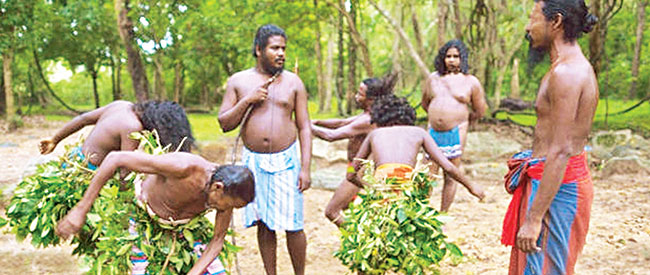
When on a camping trip with Emil van der Poorten in Kantalai in the late 1950s, an interesting legend was related to me. An elephant is supposed to have trampled the young of the small quail, whose nest happened to be on its track. The elephant did not even realize that it had crushed the quail. However, the mother bird went and told the crow, the fly and the frog what had happened. They decided to teach the elephant a lesson. The crow pecked at the eyes of the elephant and the fly deposited its eggs in the wounded eyes. As a result, the elephant was blinded, and over a period of time it became very thirsty. The frog started croaking, and the elephant thus thinking that it was close to water, went towards the direction of the croaking. The frog then led the elephant to the edge of a precipice, over which it fell and was killed.
Coastal Veddhas
Since my association with the coastal Veddhas of Panichankerni was nearly 40 years ago, I had to consult my friend Emil van der Poorten for some details. Emil owned a house at Panichankerni, which we used regularly as a base for our forays into wild places. Though the coastal Veddhas that lived in Panichankerni were not considered true Veddahs at the time, Emil and I observed that they appeared to be quite different in their lifestyle when compared to the established Tamil and Muslim populations of the eastern coast and of course the better known Veddhas of Bintenne.
The houses of the coastal veddhas were far less substantial than those of the Tamils and the Muslims and they gave the impression that they were in transition from the thatched, mobile houses of the Veddahs and the gypsies, to the more permanent dwellings of the non-aboriginal settlers. They kept the gardens around their homes clean. The compounds were littered with the light sea sand found in Panichankerni and some of the other villages around.
The Veddhas subsisted on crops grown in their chenas, as well as collections of crabs, prawns and fish they caught by throwing their nets into lagoons and estuaries around them. I think they were responsible for setting up crab and prawn traps, known in Sinhala as kotuwa in the lagoon. We never saw them doing any canoe fishing in the ocean, and neither did they go out to sea as other communities did.
They relished the flesh of the land monitor (thalagoya) but did not seem to harvest honey, though they picked palu and weera fruit in season, as anyone who lived close to those forests would do. They appeared to place a very low priority on formal education, and the majority lacked functional literacy in Tamil, which was their spoken language. They did not seem to have any deep knowledge of the jungles in the area. I do not recall the presence of any trackers of note among them.
They did not have any contact with the Veddahs of Bintenne and its adjoining country. They have lived in coastal areas for a considerable period of time. I am not sure whether they owned the land they lived in or whether they were squatters on the land after they were prevented from leading a wandering existence by laws involving land tenure brought in by the British.
They did not seem to intermarry with the mainstream Tamils of the area. It may be that the latter with their caste system looked down upon the Veddahs. Apart from caste, this dissociation could also have been forced by an economic factor, namely poverty. It did not seem likely that Veddhas, who did not possess cattle, could have provided a dowry of any significance for their daughters. They appeared to be a relatively non-violent people who subsisted on the fruits of the jungle and produce from the lagoons and perhaps the sea.

A special feature of the many occasions we spent at Panichankerni was to go onto the reef at low tide during certain times of the year, and catch crawfish or rock lobsters. These were slightly smaller than the ordinary lobsters. The crawfish is a marine species, while the crayfish is a freshwater crustacean. One rare night we literally caught a sackful of rock lobsters. Since I was nursing a cartilage injury on my knee, Emil had to carry this load all the way back to our abode on the beach.
Kalu nika
The twig of the legendary plant kalu nika is supposed to help one to achieve eternal youth. However, a kalu nika plant is supposed to be something that is extremely difficult to find. It is believed that the crow pheasant, uses a twig or two of the plant (some say it is a root), to build its nest. If one finds this nest, it should be taken to a place where two rivers or streams meet and thrown into the water. The kalu nika twigs float upstream whilst the other twigs float downstream. However, the crow pheasant, being from the cuckoo family, does not build a nest but lays its eggs in that of another bird. All cuckoos are parasitic in their breeding habits.
Another variation that I heard with regard to obtaining kalu nika, is that one must find the nest of the crow pheasant with a chick in it. One leg of the chick should be fastened by a small chain to the bottom of the nest. The parent bird will then fly off to try and get a twig of kalu nika, which has the power of breaking the chain and setting the young bird free. The kalu nika is left behind in the nest and can then be collected. In this story the crow pheasant does not use kalu nika as material to build its nest
Devil bird
The controversy and mystery of the devil bird, known as ulama in Sinhala and pe-kuruvi in Tamil, have been unresolved for a very long time. Those who have been out in the jungles at night and heard this eerie cry credited to the devil bird will never forget it. It is a piercing cry that frightens and chills one to the bone. It has been likened, by many who have heard it, to a woman being strangled. I have heard this cry when we were camping at Padaviya, in North Central Province, but not having heard the cries of a woman being strangled, I cannot make the comparison. I have also heard this same cry in Panama on the south-east coast. The cry is nevertheless very frightening.
On both occasions the sound I heard was similar. The villagers who were with us said that the cry bore ill will and that something tragic would occur soon. Even if it did occur after we left, I did not hear about it.
However there are many others who have heard the devil bird but describe what they have heard as ‘a long drawn out hoo note, persistently repeated and then ending in a loud agonized and strangled sobbing. The sound struck sheer, stark inexplicable terror, and died away somewhat abruptly’.
At night in the jungle when we discuss the events of the day, old tales, legends and superstitions are recounted. The ulama and its cry come into the conversation from time to time. The villagers, especially the old stagers, have very firm opinions as to what the ulama is. However, who or what the ulama is varies from place to place.
One of the legends has it that there was a family in which the husband was a drunkard. One day when the wife was away, he killed their small daughter and cooked the flesh. On her return, he gave it to his wife to eat. She was serving herself with a wooden ladle when she came across a little finger. She immediately asked for her daughter and on seeing her grinning husband, realized what had happened.
She was distraught and sticking the ladle into her hair in despair, she ran out of the house into the jungle shouting ‘mage lamaya ko?’ (where is my child?). In another version it is said that the husband had brought home a hunk of flesh to be cooked. While the wife was cooking it the husband started to drink. Unfortunately the wife burnt the flesh and told her husband what had happened, expecting a severe reprimand from him.
However, he did not say anything but went back towards the jungle. In the garden he spotted their daughter playing. He killed her and brought a piece of her flesh to his wife to cook. When she was cooking this flesh unsuspectingly, she came across the daughter’s finger in the ladle. She then stuck the ladle into her hair which was tied in a knot at the back of her head and ran out shouting as in the earlier version.
The source of its eerie and frightening cry has been attributed to two or three birds. The two birds that most naturalists consider as culprits are the forest eagle owl and the crested hawk eagle, now known as changeable hawk eagle. This bird’s crest, according to legend, happens to be the handle of the ladle.
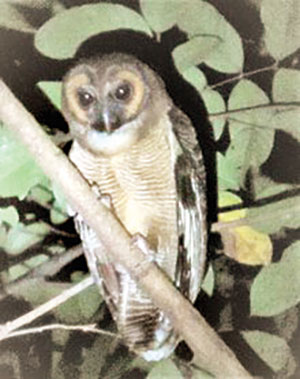
Korawakka or waterfowl
The waterfowl (korawakka) once went across the river to get some arecanut. (puwak). Since there were a number of bags of arecanut to be brought across the river, the waterfowl hired the boat belonging to the woodpecker. In the middle of the river, the boat capsized and together with the bags of arecanut sank to the bottom of the river. The wailing of the waterfowl and the woodpecker brought a flock of geese to their assistance. The geese dived in and tried to get the bags of arecanut up. However, due to the weight of the bags, the geese failed to lift them up, but in trying to do so, they stretched their necks. As a result, even to this day they carry long necks. Even now the waterfowl goes about calling puwak, puwak, puwak in search of its arecanuts and the woodpecker goes pecking from tree to tree in search of suitable wood to build himself a new boat.
Rumassala and Ritigala
When I was working in the Mahaweli Development Project at Kalawewa we used to regularly climb Ritigala, which was close by. Ritigala is now a Strict Nature Reserve. The higher you go the more changes you see in the vegetation and climate. The place abounds with bird life and unique plants.
Ramayana, the ancient Indian epic, states that Ravana the king of Lanka went to India and abducted beautiful Sita, the wife of Rama, and brought her to Lanka. Rama then came to Lanka to wage war against Ravana and take Sita back.
He brought with him a band of Vanaras, a tribe of ape-like creatures led by Hanuman. Rama was injured in the battle and Hanuman was sent to the Himalayas to bring back the herbs required for Rama’s recovery. On getting there he forgot what plants he was to bring and so he wrenched a whole chunk of the Himalayan soil including its vegetation, and started his return journey. On the way a part of this load of forest fell at Ritigala in North Central Province. The other piece was dropped off in Galle at what is now known as Rumassala.
Rumassala is next to Unawatuna, which is derived from onna watuna (there it fell). Galle is a name said to originate from gala or cattle pen, where Ravana kept his cattle. This particular place is now known as Pattiyamulla, where pattiya means herd of cattle.
Most of the flora in both these places are endemic. Ritigala is a lone mountain about 2,500 feet above sea level and rises from the plains of North Central Province. Rumassala abuts the sea and is on a hillock. Recent surveys have revealed 179 species of medicinal plants in Ritigala and 152 species in Rumassala.
Conclusion
The wild areas of Sri Lanka are rich in lore and legend. This makes one’s visits more interesting. These stories add spice to the camp gatherings at sundown when we recapitulate the day’s events, plan for the morrow and generally relax with friends in a congenial atmosphere. Sri Lanka is fast losing most of its exotic wilderness. We who have enjoyed going to these places for a long time should make every effort to ensure that they continue to exist for the future generations too.
References
Knox, Robert (1681) An historical relation of Ceylon, reprint 1958, Saman Press, Maharagama.
Brohier, R L (1971) Seeing Ceylon in vistas of scenery, history, legend and folklore, 2nd ed., Lake House Investments Ltd, Colombo.
(Concluded)
Features
The heart-friendly health minister
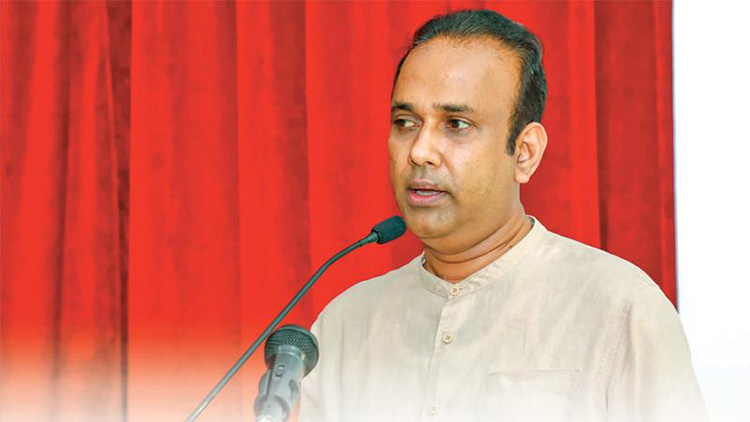
by Dr Gotabhya Ranasinghe
Senior Consultant Cardiologist
National Hospital Sri Lanka
When we sought a meeting with Hon Dr. Ramesh Pathirana, Minister of Health, he graciously cleared his busy schedule to accommodate us. Renowned for his attentive listening and deep understanding, Minister Pathirana is dedicated to advancing the health sector. His openness and transparency exemplify the qualities of an exemplary politician and minister.
Dr. Palitha Mahipala, the current Health Secretary, demonstrates both commendable enthusiasm and unwavering support. This combination of attributes makes him a highly compatible colleague for the esteemed Minister of Health.
Our discussion centered on a project that has been in the works for the past 30 years, one that no other minister had managed to advance.
Minister Pathirana, however, recognized the project’s significance and its potential to revolutionize care for heart patients.
The project involves the construction of a state-of-the-art facility at the premises of the National Hospital Colombo. The project’s location within the premises of the National Hospital underscores its importance and relevance to the healthcare infrastructure of the nation.
This facility will include a cardiology building and a tertiary care center, equipped with the latest technology to handle and treat all types of heart-related conditions and surgeries.
Securing funding was a major milestone for this initiative. Minister Pathirana successfully obtained approval for a $40 billion loan from the Asian Development Bank. With the funding in place, the foundation stone is scheduled to be laid in September this year, and construction will begin in January 2025.
This project guarantees a consistent and uninterrupted supply of stents and related medications for heart patients. As a result, patients will have timely access to essential medical supplies during their treatment and recovery. By securing these critical resources, the project aims to enhance patient outcomes, minimize treatment delays, and maintain the highest standards of cardiac care.
Upon its fruition, this monumental building will serve as a beacon of hope and healing, symbolizing the unwavering dedication to improving patient outcomes and fostering a healthier society.We anticipate a future marked by significant progress and positive outcomes in Sri Lanka’s cardiovascular treatment landscape within the foreseeable timeframe.
Features
A LOVING TRIBUTE TO JESUIT FR. ALOYSIUS PIERIS ON HIS 90th BIRTHDAY

by Fr. Emmanuel Fernando, OMI
Jesuit Fr. Aloysius Pieris (affectionately called Fr. Aloy) celebrated his 90th birthday on April 9, 2024 and I, as the editor of our Oblate Journal, THE MISSIONARY OBLATE had gone to press by that time. Immediately I decided to publish an article, appreciating the untiring selfless services he continues to offer for inter-Faith dialogue, the renewal of the Catholic Church, his concern for the poor and the suffering Sri Lankan masses and to me, the present writer.
It was in 1988, when I was appointed Director of the Oblate Scholastics at Ampitiya by the then Oblate Provincial Fr. Anselm Silva, that I came to know Fr. Aloy more closely. Knowing well his expertise in matters spiritual, theological, Indological and pastoral, and with the collaborative spirit of my companion-formators, our Oblate Scholastics were sent to Tulana, the Research and Encounter Centre, Kelaniya, of which he is the Founder-Director, for ‘exposure-programmes’ on matters spiritual, biblical, theological and pastoral. Some of these dimensions according to my view and that of my companion-formators, were not available at the National Seminary, Ampitiya.
Ever since that time, our Oblate formators/ accompaniers at the Oblate Scholasticate, Ampitiya , have continued to send our Oblate Scholastics to Tulana Centre for deepening their insights and convictions regarding matters needed to serve the people in today’s context. Fr. Aloy also had tried very enthusiastically with the Oblate team headed by Frs. Oswald Firth and Clement Waidyasekara to begin a Theologate, directed by the Religious Congregations in Sri Lanka, for the contextual formation/ accompaniment of their members. It should very well be a desired goal of the Leaders / Provincials of the Religious Congregations.
Besides being a formator/accompanier at the Oblate Scholasticate, I was entrusted also with the task of editing and publishing our Oblate journal, ‘The Missionary Oblate’. To maintain the quality of the journal I continue to depend on Fr. Aloy for his thought-provoking and stimulating articles on Biblical Spirituality, Biblical Theology and Ecclesiology. I am very grateful to him for his generous assistance. Of late, his writings on renewal of the Church, initiated by Pope St. John XX111 and continued by Pope Francis through the Synodal path, published in our Oblate journal, enable our readers to focus their attention also on the needed renewal in the Catholic Church in Sri Lanka. Fr. Aloy appreciated very much the Synodal path adopted by the Jesuit Pope Francis for the renewal of the Church, rooted very much on prayerful discernment. In my Religious and presbyteral life, Fr.Aloy continues to be my spiritual animator / guide and ongoing formator / acccompanier.
Fr. Aloysius Pieris, BA Hons (Lond), LPh (SHC, India), STL (PFT, Naples), PhD (SLU/VC), ThD (Tilburg), D.Ltt (KU), has been one of the eminent Asian theologians well recognized internationally and one who has lectured and held visiting chairs in many universities both in the West and in the East. Many members of Religious Congregations from Asian countries have benefited from his lectures and guidance in the East Asian Pastoral Institute (EAPI) in Manila, Philippines. He had been a Theologian consulted by the Federation of Asian Bishops’ Conferences for many years. During his professorship at the Gregorian University in Rome, he was called to be a member of a special group of advisers on other religions consulted by Pope Paul VI.
Fr. Aloy is the author of more than 30 books and well over 500 Research Papers. Some of his books and articles have been translated and published in several countries. Among those books, one can find the following: 1) The Genesis of an Asian Theology of Liberation (An Autobiographical Excursus on the Art of Theologising in Asia, 2) An Asian Theology of Liberation, 3) Providential Timeliness of Vatican 11 (a long-overdue halt to a scandalous millennium, 4) Give Vatican 11 a chance, 5) Leadership in the Church, 6) Relishing our faith in working for justice (Themes for study and discussion), 7) A Message meant mainly, not exclusively for Jesuits (Background information necessary for helping Francis renew the Church), 8) Lent in Lanka (Reflections and Resolutions, 9) Love meets wisdom (A Christian Experience of Buddhism, 10) Fire and Water 11) God’s Reign for God’s poor, 12) Our Unhiddden Agenda (How we Jesuits work, pray and form our men). He is also the Editor of two journals, Vagdevi, Journal of Religious Reflection and Dialogue, New Series.
Fr. Aloy has a BA in Pali and Sanskrit from the University of London and a Ph.D in Buddhist Philosophy from the University of Sri Lankan, Vidyodaya Campus. On Nov. 23, 2019, he was awarded the prestigious honorary Doctorate of Literature (D.Litt) by the Chancellor of the University of Kelaniya, the Most Venerable Welamitiyawe Dharmakirthi Sri Kusala Dhamma Thera.
Fr. Aloy continues to be a promoter of Gospel values and virtues. Justice as a constitutive dimension of love and social concern for the downtrodden masses are very much noted in his life and work. He had very much appreciated the commitment of the late Fr. Joseph (Joe) Fernando, the National Director of the Social and Economic Centre (SEDEC) for the poor.
In Sri Lanka, a few religious Congregations – the Good Shepherd Sisters, the Christian Brothers, the Marist Brothers and the Oblates – have invited him to animate their members especially during their Provincial Congresses, Chapters and International Conferences. The mainline Christian Churches also have sought his advice and followed his seminars. I, for one, regret very much, that the Sri Lankan authorities of the Catholic Church –today’s Hierarchy—- have not sought Fr.
Aloy’s expertise for the renewal of the Catholic Church in Sri Lanka and thus have not benefited from the immense store of wisdom and insight that he can offer to our local Church while the Sri Lankan bishops who governed the Catholic church in the immediate aftermath of the Second Vatican Council (Edmund Fernando OMI, Anthony de Saram, Leo Nanayakkara OSB, Frank Marcus Fernando, Paul Perera,) visited him and consulted him on many matters. Among the Tamil Bishops, Bishop Rayappu Joseph was keeping close contact with him and Bishop J. Deogupillai hosted him and his team visiting him after the horrible Black July massacre of Tamils.
Features
A fairy tale, success or debacle
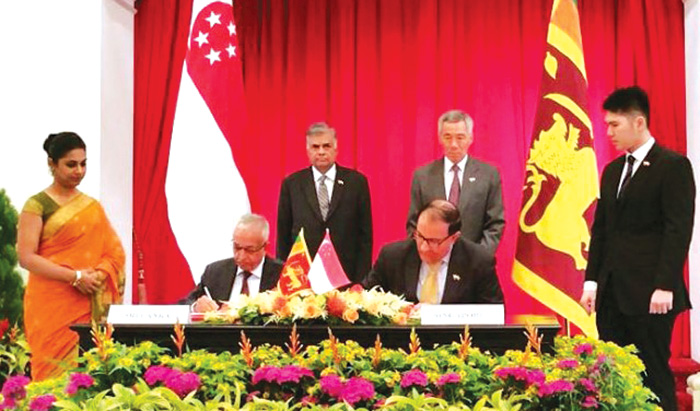
Sri Lanka-Singapore Free Trade Agreement
By Gomi Senadhira
senadhiragomi@gmail.com
“You might tell fairy tales, but the progress of a country cannot be achieved through such narratives. A country cannot be developed by making false promises. The country moved backward because of the electoral promises made by political parties throughout time. We have witnessed that the ultimate result of this is the country becoming bankrupt. Unfortunately, many segments of the population have not come to realize this yet.” – President Ranil Wickremesinghe, 2024 Budget speech
Any Sri Lankan would agree with the above words of President Wickremesinghe on the false promises our politicians and officials make and the fairy tales they narrate which bankrupted this country. So, to understand this, let’s look at one such fairy tale with lots of false promises; Ranil Wickremesinghe’s greatest achievement in the area of international trade and investment promotion during the Yahapalana period, Sri Lanka-Singapore Free Trade Agreement (SLSFTA).
It is appropriate and timely to do it now as Finance Minister Wickremesinghe has just presented to parliament a bill on the National Policy on Economic Transformation which includes the establishment of an Office for International Trade and the Sri Lanka Institute of Economics and International Trade.
Was SLSFTA a “Cleverly negotiated Free Trade Agreement” as stated by the (former) Minister of Development Strategies and International Trade Malik Samarawickrama during the Parliamentary Debate on the SLSFTA in July 2018, or a colossal blunder covered up with lies, false promises, and fairy tales? After SLSFTA was signed there were a number of fairy tales published on this agreement by the Ministry of Development Strategies and International, Institute of Policy Studies, and others.
However, for this article, I would like to limit my comments to the speech by Minister Samarawickrama during the Parliamentary Debate, and the two most important areas in the agreement which were covered up with lies, fairy tales, and false promises, namely: revenue loss for Sri Lanka and Investment from Singapore. On the other important area, “Waste products dumping” I do not want to comment here as I have written extensively on the issue.
1. The revenue loss
During the Parliamentary Debate in July 2018, Minister Samarawickrama stated “…. let me reiterate that this FTA with Singapore has been very cleverly negotiated by us…. The liberalisation programme under this FTA has been carefully designed to have the least impact on domestic industry and revenue collection. We have included all revenue sensitive items in the negative list of items which will not be subject to removal of tariff. Therefore, 97.8% revenue from Customs duty is protected. Our tariff liberalisation will take place over a period of 12-15 years! In fact, the revenue earned through tariffs on goods imported from Singapore last year was Rs. 35 billion.
The revenue loss for over the next 15 years due to the FTA is only Rs. 733 million– which when annualised, on average, is just Rs. 51 million. That is just 0.14% per year! So anyone who claims the Singapore FTA causes revenue loss to the Government cannot do basic arithmetic! Mr. Speaker, in conclusion, I call on my fellow members of this House – don’t mislead the public with baseless criticism that is not grounded in facts. Don’t look at petty politics and use these issues for your own political survival.”
I was surprised to read the minister’s speech because an article published in January 2018 in “The Straits Times“, based on information released by the Singaporean Negotiators stated, “…. With the FTA, tariff savings for Singapore exports are estimated to hit $10 million annually“.
As the annual tariff savings (that is the revenue loss for Sri Lanka) calculated by the Singaporean Negotiators, Singaporean $ 10 million (Sri Lankan rupees 1,200 million in 2018) was way above the rupees’ 733 million revenue loss for 15 years estimated by the Sri Lankan negotiators, it was clear to any observer that one of the parties to the agreement had not done the basic arithmetic!
Six years later, according to a report published by “The Morning” newspaper, speaking at the Committee on Public Finance (COPF) on 7th May 2024, Mr Samarawickrama’s chief trade negotiator K.J. Weerasinghehad had admitted “…. that forecasted revenue loss for the Government of Sri Lanka through the Singapore FTA is Rs. 450 million in 2023 and Rs. 1.3 billion in 2024.”
If these numbers are correct, as tariff liberalisation under the SLSFTA has just started, we will pass Rs 2 billion very soon. Then, the question is how Sri Lanka’s trade negotiators made such a colossal blunder. Didn’t they do their basic arithmetic? If they didn’t know how to do basic arithmetic they should have at least done their basic readings. For example, the headline of the article published in The Straits Times in January 2018 was “Singapore, Sri Lanka sign FTA, annual savings of $10m expected”.
Anyway, as Sri Lanka’s chief negotiator reiterated at the COPF meeting that “…. since 99% of the tariffs in Singapore have zero rates of duty, Sri Lanka has agreed on 80% tariff liberalisation over a period of 15 years while expecting Singapore investments to address the imbalance in trade,” let’s turn towards investment.
Investment from Singapore
In July 2018, speaking during the Parliamentary Debate on the FTA this is what Minister Malik Samarawickrama stated on investment from Singapore, “Already, thanks to this FTA, in just the past two-and-a-half months since the agreement came into effect we have received a proposal from Singapore for investment amounting to $ 14.8 billion in an oil refinery for export of petroleum products. In addition, we have proposals for a steel manufacturing plant for exports ($ 1 billion investment), flour milling plant ($ 50 million), sugar refinery ($ 200 million). This adds up to more than $ 16.05 billion in the pipeline on these projects alone.
And all of these projects will create thousands of more jobs for our people. In principle approval has already been granted by the BOI and the investors are awaiting the release of land the environmental approvals to commence the project.
I request the Opposition and those with vested interests to change their narrow-minded thinking and join us to develop our country. We must always look at what is best for the whole community, not just the few who may oppose. We owe it to our people to courageously take decisions that will change their lives for the better.”
According to the media report I quoted earlier, speaking at the Committee on Public Finance (COPF) Chief Negotiator Weerasinghe has admitted that Sri Lanka was not happy with overall Singapore investments that have come in the past few years in return for the trade liberalisation under the Singapore-Sri Lanka Free Trade Agreement. He has added that between 2021 and 2023 the total investment from Singapore had been around $162 million!
What happened to those projects worth $16 billion negotiated, thanks to the SLSFTA, in just the two-and-a-half months after the agreement came into effect and approved by the BOI? I do not know about the steel manufacturing plant for exports ($ 1 billion investment), flour milling plant ($ 50 million) and sugar refinery ($ 200 million).
However, story of the multibillion-dollar investment in the Petroleum Refinery unfolded in a manner that would qualify it as the best fairy tale with false promises presented by our politicians and the officials, prior to 2019 elections.
Though many Sri Lankans got to know, through the media which repeatedly highlighted a plethora of issues surrounding the project and the questionable credentials of the Singaporean investor, the construction work on the Mirrijiwela Oil Refinery along with the cement factory began on the24th of March 2019 with a bang and Minister Ranil Wickremesinghe and his ministers along with the foreign and local dignitaries laid the foundation stones.
That was few months before the 2019 Presidential elections. Inaugurating the construction work Prime Minister Ranil Wickremesinghe said the projects will create thousands of job opportunities in the area and surrounding districts.
The oil refinery, which was to be built over 200 acres of land, with the capacity to refine 200,000 barrels of crude oil per day, was to generate US$7 billion of exports and create 1,500 direct and 3,000 indirect jobs. The construction of the refinery was to be completed in 44 months. Four years later, in August 2023 the Cabinet of Ministers approved the proposal presented by President Ranil Wickremesinghe to cancel the agreement with the investors of the refinery as the project has not been implemented! Can they explain to the country how much money was wasted to produce that fairy tale?
It is obvious that the President, ministers, and officials had made huge blunders and had deliberately misled the public and the parliament on the revenue loss and potential investment from SLSFTA with fairy tales and false promises.
As the president himself said, a country cannot be developed by making false promises or with fairy tales and these false promises and fairy tales had bankrupted the country. “Unfortunately, many segments of the population have not come to realize this yet”.
(The writer, a specialist and an activist on trade and development issues . )




